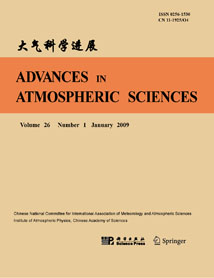| [1] |
Reshmita NATH, Debashis NATH, Qian LI, Wen CHEN, Xuefeng CUI,
2017: Impact of Drought on Agriculture in the Indo-Gangetic Plain, India, ADVANCES IN ATMOSPHERIC SCIENCES, 34, 335-346.
doi: 10.1007/s00376-016-6102-2
|
| [2] |
Riyu LU, Saadia HINA, Xiaowei HONG,
2020: Upper- and Lower-tropospheric Circulation Anomalies Associated with Interannual Variation of Pakistan Rainfall during Summer, ADVANCES IN ATMOSPHERIC SCIENCES, 37, 1179-1190.
doi: 10.1007/s00376-020-0137-0
|
| [3] |
WANG Mingxing, LIU Qiang, YANG Xin,
2004: A Review of Research on Human Activity Induced Climate Change I. Greenhouse Gases and Aerosols, ADVANCES IN ATMOSPHERIC SCIENCES, 21, 314-321.
doi: 10.1007/BF02915561
|
| [4] |
Xiang LI, Yiyong LUO,
2016: Response of North Pacific Eastern Subtropical Mode Water to Greenhouse Gas Versus Aerosol Forcing, ADVANCES IN ATMOSPHERIC SCIENCES, 33, 522-532.
doi: 10.1007/s00376-015-5092-9
|
| [5] |
Israel LOPEZ-COTO, Subhomoy GHOSH, Kuldeep PRASAD, James WHETSTONE,
2017: Tower-Based Greenhouse Gas Measurement Network Design——The National Institute of Standards and Technology North East Corridor Testbed, ADVANCES IN ATMOSPHERIC SCIENCES, 34, 1095-1105.
doi: 10.1007/s00376-017-6094-6
|
| [6] |
A. Longhetto, S. Ferrarese, C. Cassardo, C. Giraud, F. Apadttla, P. Bacci, P. Bonelli, A. Marzorati,
1997: Relationships between Atmospheric Circulation Patterns and CO2 Greenhouse-Gas Concentration Levels in the Alpine Troposphere, ADVANCES IN ATMOSPHERIC SCIENCES, 14, 309-322.
doi: 10.1007/s00376-997-0052-7
|
| [7] |
Yuan QIU, Jinming FENG, Zhongwei YAN, Jun WANG,
2022: High-resolution Projection Dataset of Agroclimatic Indicators over Central Asia, ADVANCES IN ATMOSPHERIC SCIENCES, 39, 1734-1745.
doi: 10.1007/s00376-022-2008-3
|
| [8] |
Michael Brody, Maksim Kulikov, Sagynbek Orumbaev, Peter van Oevelen,
2024: The Global Energy and Water Exchanges Project in Central Asia; The Case for a Regional Hydroclimate Project, ADVANCES IN ATMOSPHERIC SCIENCES.
doi: 10.1007/s00376-023-3384-z
|
| [9] |
Michael BRODY, Maksim KULIKOV, Sagynbek ORUNBAEV, Peter J. VAN OEVELEN,
2024: The Global Energy and Water Exchanges (GEWEX) Project in Central Asia: The Case for a Regional Hydroclimate Project, ADVANCES IN ATMOSPHERIC SCIENCES, 41, 777-783.
doi: 10.1007/s00376-023-3384-2
|
| [10] |
ZHENG Xunhua, LIU Chunyan, HAN Shenghui,
2008: Description and Application of a Model for Simulating Regional Nitrogen Cycling and Calculating Nitrogen Flux, ADVANCES IN ATMOSPHERIC SCIENCES, 25, 181-201.
doi: 10.1007/s00376-008-0181-7
|
| [11] |
MA Xiaoyan, GUO Yufu, SHI Guangyu, YU Yongqiang,
2004: Numerical Simulation of Global Temperature Change during the 20th Century with the IAP/LASG GOALS Model, ADVANCES IN ATMOSPHERIC SCIENCES, 21, 227-235.
doi: 10.1007/BF02915709
|
| [12] |
Zheng Xunhua, Wang Mingxing, Wang Yuesi, Shen Renxing, Li Jing, J. Heyer, M. Koegge, H. Papen,
2000: Mitigation Options for Methane, Nitrous Oxide and Nitric Oxide Emissions from Agricultural Ecosystems, ADVANCES IN ATMOSPHERIC SCIENCES, 17, 83-92.
doi: 10.1007/s00376-000-0045-2
|
| [13] |
B. ABISH, P.V. JOSEPH, Ola. M. JOHANNESSEN,
2015: Climate Change in the Subtropical Jetstream during 1950-2009, ADVANCES IN ATMOSPHERIC SCIENCES, 32, 140-148.
doi: 10.1007/s00376-014-4156-6
|
| [14] |
Ting WEI, Wenjie DONG, Qing YAN, Jieming CHOU, Zhiyong YANG, Di TIAN,
2016: Developed and Developing World Contributions to Climate System Change Based on Carbon Dioxide, Methane and Nitrous Oxide Emissions, ADVANCES IN ATMOSPHERIC SCIENCES, 33, 632-643.
doi: 10.1007/s00376-015-5141-4
|
| [15] |
Qin SU, Buwen DONG, Fangxing TIAN, Nicholas P. KLINGAMAN,
2024: Anthropogenic Influence on Decadal Changes in Concurrent Hot and Dry Events over China around the Mid-1990s, ADVANCES IN ATMOSPHERIC SCIENCES, 41, 233-246.
doi: 10.1007/s00376-023-2319-z
|
| [16] |
Zhe WANG, Zifa WANG, Zhiyin ZOU, Xueshun CHEN, Huangjian WU, Wending WANG, Hang SU, Fang LI, Wenru XU, Zhihua LIU, Jiaojun ZHU,
2024: Severe Global Environmental Issues Caused by Canada’s Record-Breaking Wildfires in 2023, ADVANCES IN ATMOSPHERIC SCIENCES, 41, 565-571.
doi: 10.1007/s00376-023-3241-0
|
| [17] |
Shi Guangyu, Fan Xiaobiao,
1992: Past, Present and Future Climatic Forcing due to Greenhouse Gases, ADVANCES IN ATMOSPHERIC SCIENCES, 9, 279-286.
doi: 10.1007/BF02656938
|
| [18] |
WANG Yuesi, HU Yuqiong, JI Baoming, LIU Guangren, XUE Min,
2003: An Investigation on the Relationship Between Emission/Uptake of Greenhouse Gases and Environmental Factors in Semiarid Grassland, ADVANCES IN ATMOSPHERIC SCIENCES, 20, 119-127.
doi: 10.1007/BF03342056
|
| [19] |
CHANG Wenyuan, LIAO Hong, WANG Huijun,
2009: Climate responses to direct radiative forcing of anthropogenic aerosols, tropospheric ozone, and long-lived greenhouse gases in eastern China over 1951-2000, ADVANCES IN ATMOSPHERIC SCIENCES, 26, 748-762.
doi: 10.1007/s00376-009-9032-4
|
| [20] |
K. Hussain, Ruby Riffat, A. Shaukat, M. Ashraf Siddiqui,
1990: A Study of Suspended Participate Matter in Lahore (Pakistan), ADVANCES IN ATMOSPHERIC SCIENCES, 7, 178-185.
doi: 10.1007/BF02919155
|















 AAS Website
AAS Website 
 AAS WeChat
AAS WeChat 
 DownLoad:
DownLoad: